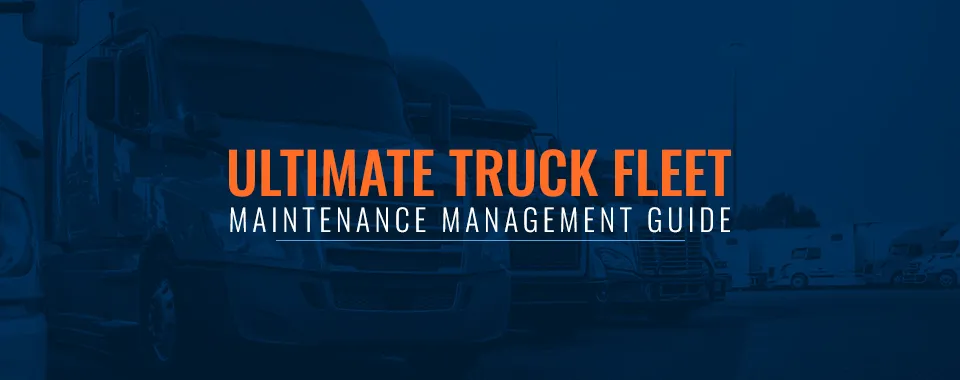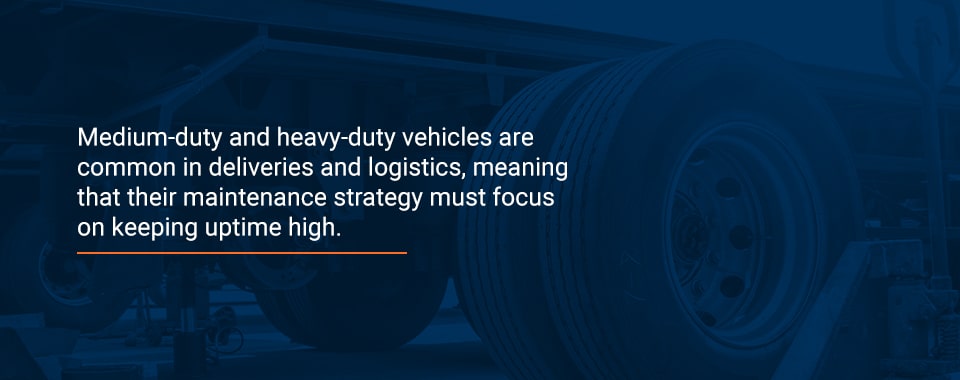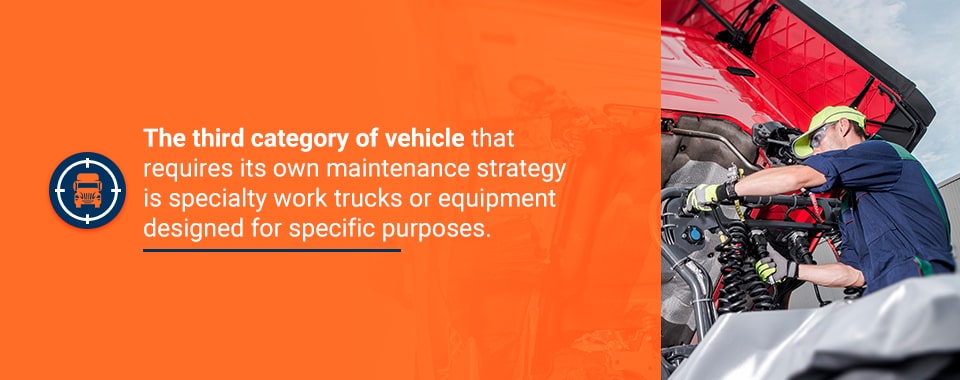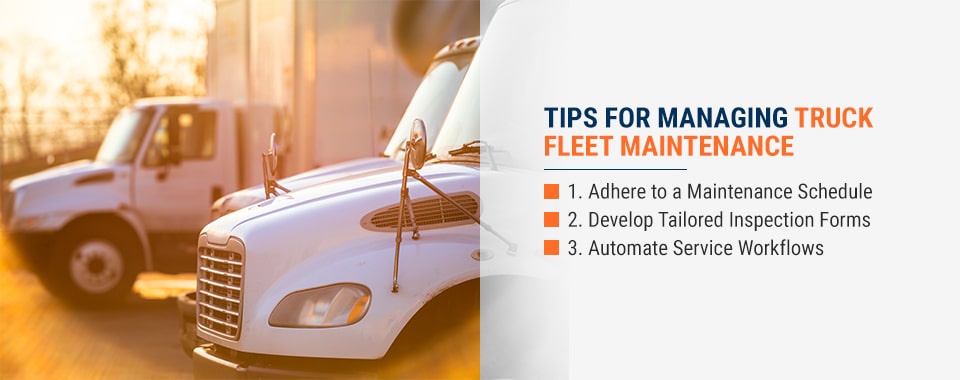

Managing a fleet of trucks requires diligent attention to your maintenance program. From daily inspections to scheduled maintenance to ongoing repairs, fleet managers have many responsibilities to consider. By leveraging fleet maintenance software, managers can drastically improve their workflows.
This guide to fleet maintenance management will help you develop a comprehensive preventive maintenance plan to keep your trucks in safe and optimal working condition. We’ll share some of the benefits of automation and GPS technology that help streamline your maintenance efforts, saving you time and money.

To develop a comprehensive trucking fleet maintenance plan, managers need to understand the goals of preventive maintenance. If you’re a fleet maintenance manager, your responsibilities extend beyond the fleet to the company’s entire bottom line. From customer service to employee engagement to brand reputation, fleet maintenance management can have a major impact on the entire business.
Fleet managers have certain key performance indicators (KPIs) they use to measure success, with operating costs, safety records and productivity being a few of them. By getting clear on the biggest objectives of fleet maintenance, managers can position their efforts toward achieving goals that play a major role in the overall company’s vision.
These are the two main goals of truck fleet maintenance for managers to consider.

When managing a fleet of vehicles, a team can experience two types of downtime 一 planned and unplanned. Planned downtime occurs when a fleet vehicle is out of order for scheduled maintenance. Planned, maintenance-related downtime can be factored into the operating budget, giving managers room to reschedule deliveries or servicing appointments and implement a backup plan while a vehicle is out of commission. Unplanned downtime is a sudden and unscheduled interruption in productivity due to unforeseen or unaccounted for maintenance issues or accidents.
Downtime is a major resource drain on all businesses that manage a fleet of trucks. Unproductive downtime can quickly rack up costs, creating a ripple effect that eats into other areas of the operating budget. Downtime halts productivity while the vehicle gets serviced and can result in significant replacement or repair costs, which can be especially detrimental to small businesses.
Adequately managing truck fleet maintenance will result in better adherence to service intervals and routine maintenance to mitigate the risk of unplanned downtime. Keeping a high rate of uptime by pre-planning maintenance activities should be the biggest priority for truck fleet maintenance managers.

Investing in fleet vehicles is a massive asset that business owners want to maximize. Getting the most out of your fleet vehicles will optimize your return on investment, allowing you to benefit from your vehicle for as long as possible. The quality and consistency of maintenance greatly determine how long a fleet vehicle will last.
While many businesses choose to liquidate their fleet vehicles at a particular milestone, such as at 100,000 miles, extending your vehicle’s service life for as long as possible is still important. This is especially important during times of economic stagnation when investing in a new fleet vehicle isn’t feasible. Adhering to high maintenance standards for your fleet vehicles will also reduce their depreciation rate and help your assets retain a higher value, which you can leverage at resale time.
Automating your preventive maintenance can help your business achieve these two crucial goals. Learn how to develop a maintenance plan depending on the type of vehicles you have and how Track Your Truck’s GPS tracking technology can help streamline routine fleet maintenance.
Though all fleet managers share the same primary goals of preventing downtime and extending the service life of their vehicles, the strategy used to achieve these goals can differ broadly between fleets. Fleet maintenance managers should develop their fleet maintenance strategy based on the vehicle class and the type of wear and tear most likely to occur to these vehicles.
Discover what to prioritize when developing your truck fleet maintenance strategy for light-duty, medium- and heavy-duty and specialty truck fleets.

Light-duty fleet vehicles are class 1 and class 2 commercial motor vehicles with a gross vehicle weight rating (GVWR) of 10,000 pounds or less. These light-duty vehicles typically make up fleets for utility services, plumbers, HVAC techs, broadband providers and landscaping businesses. Delivery vans and trucks and other logistics providers also make up a significant portion of this fleet vehicle category. Regardless of the type of service, light-duty fleet trucks commonly operate in urban and suburban traffic, facing challenges like congestion, construction and frequent stops that increase wear and tear.
When developing a truck fleet maintenance strategy for light-duty vehicles, it’s important to have a reliable way to measure mileage, which is the key indicator that will inform your preventive maintenance plan. Because your team uses these vehicles daily, your priority should be on daily vehicle inspections that allow drivers to act as the first line of defense against symptoms of an impending breakdown.
The combination of daily inspections and consistent servicing will ensure that your light-duty fleet can meet the two main goals of preventive maintenance. To be successful, fleet maintenance managers need to give drivers the tools to perform streamlined daily inspections and report any issues they find. Managers must also leverage fleet maintenance technology, including GPS tracking, to ensure accurate mileage recording necessary for maintenance scheduling.

Medium-duty trucks are class 3, 4, 5 and 6 commercial vehicles with a GVWR of between 10,001 and 26,000 pounds. Heavy-duty trucks are class 7 vehicles with a GVWR of 26,001 to 33,000 pounds or class 8 with a GVWR of 33,001 pounds or more.
Medium-duty and heavy-duty vehicles are common in deliveries and logistics, meaning that their maintenance strategy must focus on keeping uptime high. Additionally, these heavier duty commercial vehicles face strict Department of Transportation (DOT) regulation criteria, meaning that keeping detailed operator records and maintenance histories is crucial for achieving compliance.
Businesses running fleets of medium- and heavy-duty trucks will also want to prioritize asset visibility 一 the ability to track and locate fleet trucks in real-time to collect accurate mileage data and resolve any sudden issues with an immediate response. Real-time tracking is also a proactive maintenance strategy, allowing fleet managers to direct drivers along the most efficient routes. Maximizing delivery route efficiency reduces unnecessary wear and tear and fuel consumption.
This automated and technology-integrated approach to fleet maintenance can improve compliance, driver safety, vehicle reliability and customer satisfaction. It can also save managers time by automating maintenance workflows for these high-value and high-volume fleets.

The third category of vehicle that requires its own maintenance strategy is specialty work trucks or equipment designed for specific purposes. These assets typically belong to public works, private utilities or contracting companies. Examples of specialty trucks include:
The maintenance strategy approach for specialized trucks and equipment is entirely different from maintaining a fleet of light-, medium- or heavy-duty commercial vehicles because these types of trucks have a different operating environment and utilization than your everyday delivery trucks. Significant idle time, frequent stop and go, and off-road driving may be factors in-play for these vehicles.
To develop a maintenance strategy for specialized trucks and equipment, fleet managers need customizable fleet maintenance software that allows them to tailor the maintenance workflows and systems to meet the fleet’s specific needs. This ensures they can meet the unique needs of these specialty vehicles and maximize their productivity. Extending these fleet vehicles’ service life is important because these trucks usually require a massive financial investment, often involving custom upfitting.
Fleet managers planning their truck fleet maintenance strategy can greatly benefit from GPS tracking and the integrated maintenance software available from Track Your Truck.

Managing truck fleet maintenance is a lot of work. Service items and inspection reports can easily fall through the cracks if you don’t have a plan and a system for tracking your fleet status.
When looking for ways to improve fleet truck maintenance management, start by assessing where you currently are. Consider your answers to some of these questions about how you manage your truck fleet maintenance:
The following tips for managing truck fleet maintenance can help you create a complete system for executing your fleet maintenance strategy.
To minimize premature wear and tear and reduce the risk of sudden breakdowns that cause unplanned downtime, fleet maintenance managers should ensure vehicles receive service at the required intervals.
Every fleet vehicle, whether it’s a delivery vehicle, a service van or a garbage truck, should have its own maintenance schedule based on its usage. Because different maintenance items need to be done at different times, fleet managers should develop weekly, monthly, quarterly and annual maintenance schedules.
Scheduled maintenance can include items like:
How often these items get addressed depends on the purpose of your fleet and the amount of driving. Delivery vehicles that are on the road all day making frequent stops and racking up the miles need to be serviced more often than specialty trucks that get dispatched infrequently. Always consult your manufacturer’s service intervals for guidelines on when to perform each maintenance task.
Sticking to a routine maintenance schedule ensures your warranty remains valid. It also helps reduce your total cost of ownership as your fleet vehicles age. Well-serviced vehicles cost less to repair because they’re less likely to require expensive replacements as the vehicle gets older.
In addition to planned maintenance schedules, fleet managers should also develop inspection forms for drivers to complete daily. Daily inspections are a significant component of properly managing truck fleet maintenance.
Some of the benefits of daily inspections include:
Daily inspections should include a checklist of items to look at both before and after operation. These can include safety items like windshields, seat belts, horns and lights, as well as body checks for damage, leaks or new issues. It’s important to tailor your daily inspection forms to your fleet’s unique needs and workflows.
To streamline the inspection process, fleet managers should provide drivers with an easy way to perform and record their inspection findings. The best way is through fleet management software that drivers can access on a mobile device. This is a less time-consuming and more permanent method than pen and paper checklists, especially for growing fleets. Digital inspections help you to standardize the process and easily add to and revise the checklist as needed.
The smartest way to manage truck fleet maintenance is to automate as many maintenance and inspection tasks as possible.
Here are some of the maintenance and inspection items you can automate for a more efficient truck fleet maintenance plan:
Automating maintenance and inspection workflows helps you achieve your two main goals of truck fleet maintenance. Setting a maintenance schedule with automatic servicing alerts helps you plan for downtime. Additionally, getting your trucks into the shop regularly will help you extend their service life. Automation also helps you keep your maintenance costs in check, reducing your total cost of ownership and maximizing your investment in your fleet vehicles.

If you’re ready to take your fleet truck maintenance strategy to the next level, consider the benefits of fleet tracking technology for automating and recording your maintenance activities across your fleet. Fleet tracking technology uses GPS tracking to monitor your fleet, including the activities and behaviors that directly affect your maintenance responsibilities.
With GPS tracking technology, you can keep automated mileage records, observe driving behavior that causes extra wear and tear, improve fuel economy, plan the most efficient routes and even set up maintenance alerts.
GPS tracking for fleets helps you streamline your scheduled maintenance so you can prevent downtime and extend vehicle service life. Here are five ways GPS tracking can help with managing truck fleet maintenance.
GPS tracking technology allows fleet managers to track actual vehicle use more accurately than tracking mileage. With increased visibility into your fleet’s use, you can create intelligent plans to manage vehicles more efficiently.
With GPS tracking, you can make informed fleet maintenance strategy decisions, including:
GPS tracking devices and integrated software are ideal for monitoring driver behavior. In real time, managers can gain insight into problematic driving habits that lead to excessive wear and tear. Fleet vehicles that are properly driven and well-maintained experience far fewer maintenance concerns and reap the benefits of extended service life.
Some of the driver behaviors that GPS tracking can help you identify include:
Many of these behaviors can also put the driver at risk of costly accidents, which add to your maintenance and liability costs. GPS technology that records driving behaviors can help you mitigate risk and lower your total cost of ownership.
To maintain high productivity, achieve customer satisfaction and deliver services on time, fleet managers need to take route planning seriously. Planning the most efficient route possible helps your company get more done in one day while reducing fuel costs from needless driving miles.
Efficient route planning is also critical to maximizing vehicle health. The more miles driven, the more wear and tear the vehicle undergoes and the more frequently it will need servicing. GPS tracking helps managers optimize their routes, dispatching drivers along the most efficient route and redirecting them as necessary, drastically cutting back on mileage. When an emergency or unforeseen obstacle occurs along the planned route, managers can reroute the driver to avoid prolonged driving or idle time.
GPS tracking paints an accurate picture of your vehicle’s health. With the data collected through GPS tracking devices and software, fleet truck maintenance managers can easily develop and adhere to routine maintenance schedules.
GPS tracking data can help you optimize your preventive maintenance plan and plan for downtime. GPS tracking gives managers the information they need to schedule maintenance when it will have the least impact on productivity. Automate fleet vehicle maintenance with help from GPS tracking.
GPS tracking technology offers a convenient way to automate your maintenance needs and helps ensures that you can adhere to your maintenance schedule. By setting up maintenance and service alerts, you’ll be one step ahead. Customize your alerts so you get the information you want when you need it.
For example, you can set reminders to alert you to maintenance requirements after a certain number of miles have been driven. With the alert system, you can also schedule reminders for upcoming vehicle inspections and repairs so you never fall behind schedule.
Developing an informed and strategic preventive maintenance plan is one of the most important investments fleet managers can make. Staying on top of preventive maintenance, inspections and repairs can reduce unplanned downtime and help your vehicles retain their value and longevity. To stay ahead of planned maintenance, you need the best technology and tools to automate maintenance items and ensure they get done on time.
GPS tracking from Track Your Truck offers you a comprehensive fleet tracking program that’s ideal for busy fleet managers. Find out more about the Track Your Truck features that can optimize your fleet truck maintenance plan. Schedule a demo today or request a free quote.